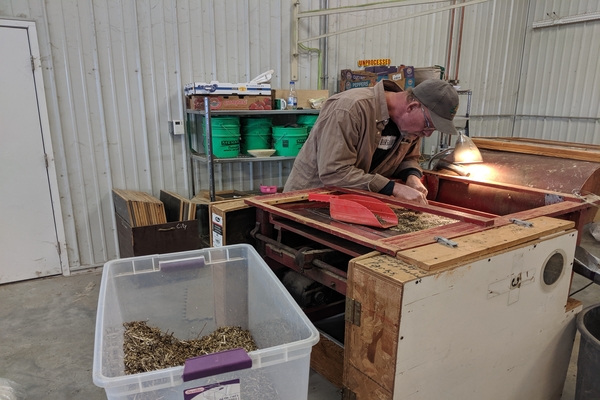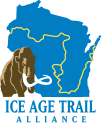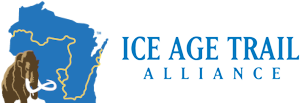By Eva Ballering, Land Steward at the Ice Age Trail Alliance

Following the phenology of the season can be one of life’s greatest pleasures for prairie enthusiasts. With the late summer burst of color, in its final hurrah for the season, the majority of plants start to wind down and prepare for winter. Although this is a notable event, the prairie has been busy all season. By the time the prairie is in full bloom, many species have already taken their turn to flower, attract pollinators, and produce seed.
Throughout the variety of our Wisconsin Biomes, one thing above all speaks to the resiliency of our increasingly fragmented ecosystems – biodiversity. In land stewardship, increasing biodiversity usually means fighting invasive species but this work can also revolve around returning biodiversity to the landscape via seeding.
Apart from beautiful blossoms, these seeds may be the most desirable ‘commodity’ produced by the prairie. Commercially purchased seed can cost over a thousand dollars per acre. As many prairie restoration projects are supported by non-profits or private land owners, seed costs can be a limiting factor. The answer to this problem is simple – and fun – as seed collecting can be done by just about anyone.
Phenology (fee·nah·luh·jee):
The study of plant and animal life cycle events and how these are influenced by seasonal and yearly variations in climate, as well as habitat factors.

Volunteer opportunities can be found with groups such as Dane County Parks, Swamplovers Foundation and many others offering a foray into seed collecting. Each year thousands of pounds of seed are collected, non-commercially, to be used and shared across a community or region.
As species takes turn producing seed, collectors watch for signs that they are ready to harvest. Using visual and tactile cues, seasoned seed collectors identify when each species seed is ready for harvest. Collectors have to be vigilant not to miss the short window for each species when seeds are ripe, as they can quickly fall from the plant once viable.
Seed is usually collected by cutting off the flower head with garden pruners or stripping the seeds directly off the plant by hand. It’s collected in a bucket or sac but must be quickly set out to dry where there is more air circulation to keep the plant material from rotting. After the collected seed is dried it is stripped of excess plant material and chaff using a hammer mill or similar machine. The output from this process is not yet clean seed, it is a mixture of broken up plant material and seed. The next step is to separate out the seed using a screen of the right diameter, allowing the heavier seed to drop through while disposing of other debris.
This screening process is called winnowing and requires an understanding of the species being cleaned because seeds ranges greatly in size. For example, one ounce of Cardinal Flower (Lobelia cardinalis) contains roughly 400,000 seeds while Wild Lupine (Lupinus perennis) has closer to 1,100 seeds per ounce.
Winnowing the majority of seeds is done with a fan mill which vibrates to shake the seeds through while at the same time, blows away remaining chaff. For highly desirable seed, whether it be due to price, personal preference, or limited supply, screening can be done by hand to insure a more controlled outcome.

The size and amount of seeds per ounce may seem like it would dictate the price for seed, but the true cost is associated with the amount available to be commercially harvested as well as the ease of harvesting and processing.

In comparison to self-harvested seed, commercial collection is usually done in nursery plots with machines instead of by hand in natural areas. This allows commercial seed companies to control the quantity and quality of their product. Additionally, commercial seed usually has a higher Percent Live Seed (PLS) rating, meaning the percent of viable seed in any given amount is greater than what is collected by volunteers and land stewards. While this is an incentive to purchase commercial seed, this should be no deterrent in collecting one’s own seed though, as seed collecting is a great way to get outdoors and give back to the land.
Tips for Seed Collection, Preparation, & Storage
Collection:
- Seedheads can ripen quickly, and must be watched carefully in order to collect the seed before they are dispersed. As a rough guide, seed is set about two months after flowering.
- Choose the best plants to collect seed from. Plants should be healthy and vigorous. This will help ensure good quality seedlings and plants.
Preparation:
- Pick the seedheads, either singly or on stalks, and lay them out to dry on a greenhouse bench, warm windowsill, paper bag, or in an airing cupboard. This enables seed to be more easily extracted from pods, cones or capsules. If they don’t open when dry, gently crush pods and capsules to release the seed.
- After extracting the seed, clean off any surrounding material (chaff) attached to them, as this material could rot. This can be done by hand screening or with a hammer mill or other device.
Storage:
- Place dry seed in labelled paper packets or envelopes in an airtight container with some desiccant to remove excess moisture. Excess humidity or warmth can cause seed to deteriorate or die from fungal disease or rotting.
- Store in a refrigerator around 41°F until seeds are required. Most seed will remain viable in this way for many years.
Please note: While you are free to collect seeds on your own land, harvesting on WI state lands and other public lands requires a permit. Contact the WI Department of Natural Resources to learn more about seed permits on state land.
Reach out to Eva Ballering at Eva@iceagetrail.org with your questions about seed collecting or to learn about upcoming seed collecting events with the Ice Age Trail Alliance and local nonprofits.

